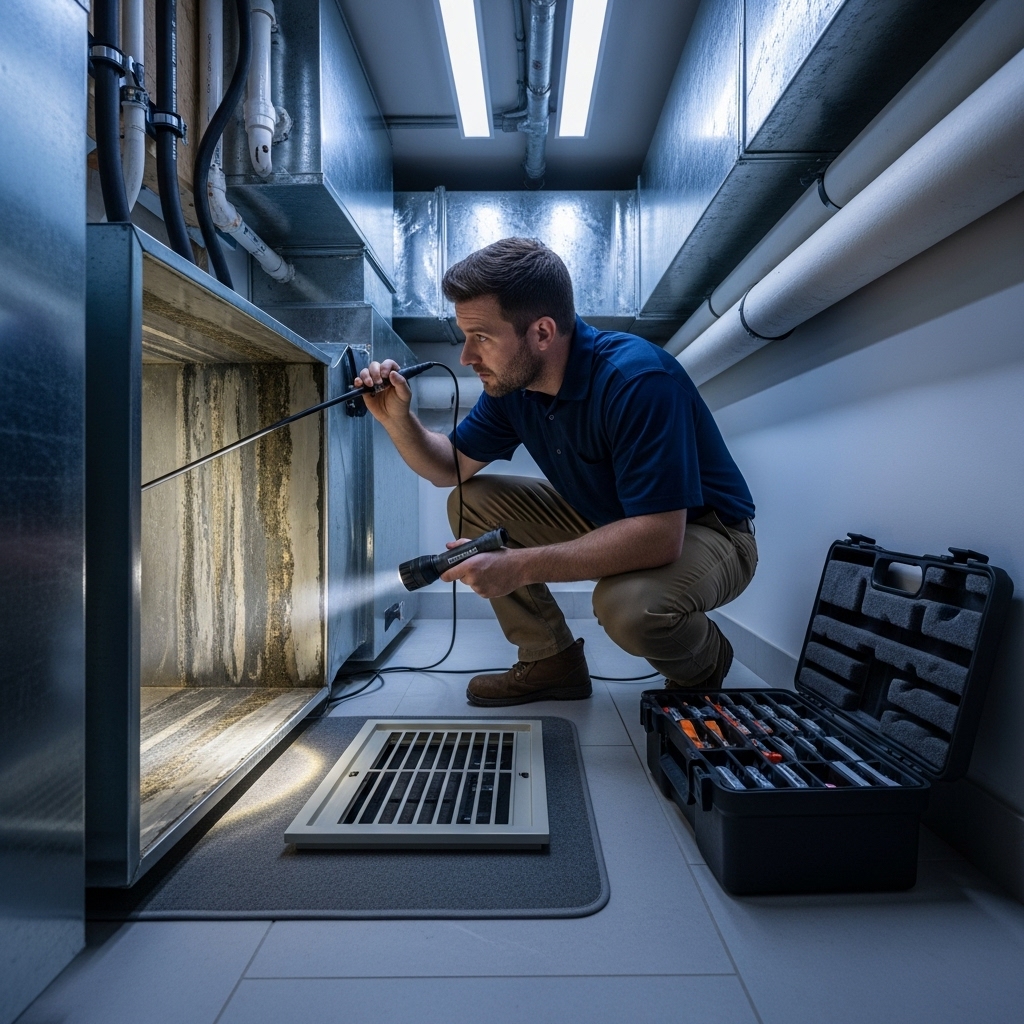There is a particular quiet that settles over Beverly Hills homes when the HVAC fan clicks off—the kind of quiet that lets you hear the ocean even from a few blocks inland. That calm is part of why we live here. It is also why we notice so quickly when something in our indoor air feels off. Maybe there is a faint smoky note after a windy night, or a room that never quite catches up with the thermostat. When you schedule an air duct cleaning inspection, you are asking a simple question: what is happening in the pathways that move air through my home? As a local who has spent years peering into returns and supply runs from the Pier to the canyons, I can tell you exactly what to expect and how a good inspection sets you up for cleaner, quieter comfort.
Setting the Stage: Before the Inspection
A useful visit starts before anyone opens a register. You will talk through your home’s history—recent renovations, wildfire smoke exposure, humidity issues during the marine layer, or that stubborn room over the garage. This context helps the technician prioritize which runs to scope first and which transitions may hide trouble. If you can, clear a little space around returns and the air handler so access is easy. In Beverly Hills’s more architectural homes, mechanical closets can be tight; a few minutes of prep makes a big difference.
Do a quick walk-through with your own senses the day before. Note which rooms feel stagnant, which registers sound rattly, and where you catch whiffs of dust or smoke. Those observations become a checklist that guides the inspection and makes the final report feel tailored to your experience rather than generic.
What Gets Inspected—and Why
A thorough inspection focuses on three zones: returns, supply runs, and the air handler. Returns reveal how the system is drawing air. If there are gaps around a return plenum or an attic transition, the system may be inhaling dusty air from places you would rather keep separate. Supply runs show what your rooms are actually receiving—dust films, soot, or debris that can slow airflow and carry odors. The air handler ties it together; residue on the blower or coil housing can indicate that fine particles have been circulating for a while.
In Beverly Hills, the mix is distinct. On the coast, expect a fine salt shimmer and the occasional sand fleck near beach entries. In the canyons, look for dried leaf fragments and powdery dust from trails and landscaping. After a season with fires anywhere upwind, ultra-fine soot can give duct walls a faint gray cast that holds odor even when the air tastes clean outside. Knowing these patterns helps the tech distinguish normal background from issues that call for deeper cleaning or repairs.
Tools You Might See
Modern inspections rely on a few simple but powerful tools. A small camera or borescope shows the interior of ducts without invasive cuts, while a bright light and mirror help at registers. An anemometer may be used to get a snapshot of airflow from major supplies, and a particle counter can illustrate the difference between return and supply air when issues are suspected. None of this needs to be disruptive; used well, the tools confirm what experience suggests and give you visuals to understand the recommendations.
Containment equipment matters more during the cleaning phase, but a thoughtful inspector will still protect finishes during access, especially in high-design Beverly Hills interiors. Expect drop cloths, gentle removal of grilles, and careful hardware tracking so every vent goes back exactly as it was.
Signs the Inspector Is Looking For
Inside returns, the focus is on gaps, stains, and dust patterns that indicate where air has been coming from. In supply runs, the telltales include visible dust lines at joints, clumps of debris at turns, or a uniform gray film that suggests smoke exposure. A quick wipe that yields a pronounced black streak is a strong sign of soot. The air handler can reveal more: blades dusted with fine powder, a coil housing with a dull film, or evidence of bypass around a filter that allowed particles to circulate more freely than intended.
Outside the ducts, inspectors also look at the context. Are kitchen and bath vents working? Is there a musty note near a laundry area that might hint at humidity issues? Beverly Hills’s marine layer can create subtle moisture problems that complicate odors, and it is worth addressing them alongside cleaning so your results last.
How Long It Takes and What You Do During
Most inspections are straightforward and unhurried. In a typical Beverly Hills home, expect an hour or two depending on layout complexity and access. You can go about your day. If you work from home, you might want a quiet corner for calls while registers are being accessed. The process is not messy; the goal is to gather information with minimal disruption so you can make a clear decision about next steps.
If your home has special considerations—high ceilings, art near registers, or delicate finishes—mention them at the start. The best technicians appreciate the heads-up and will plan their approach accordingly.
From Findings to a Plan
The difference between a cursory look and a helpful inspection is the plan that follows. You should receive a clear summary of what was found, ideally with images from key locations. Recommendations might include targeted cleaning of specific runs, a whole-system service, filter upgrades, sealing of return leaks, or attention to the air handler if residue is heavy. In Beverly Hills, it is common to see a tailored approach: perhaps a full return-side cleaning with focused work on long supply runs that pass through warm attics, plus a fresh filter matched to wildfire season.
A good plan respects your priorities. If odor is your primary complaint, the sequence may start with cleaning and filtration. If certain rooms lag, you may address airflow balance alongside cleaning. The point is to solve the problems you feel, not just the ones that look dramatic in photos.
Wildfire Season: Special Protocols
When smoke has been in the picture, inspectors watch for ultra-fine residues and subtle odor sources. They may recommend timely cleaning to prevent those particles from continuing to recirculate, along with a filter change calibrated for the season. In many Beverly Hills homes, a mid-season check is wise if winds and smoke events continue. This is especially true in the canyons, where smoke can linger even after the beachside air has cleared.
Residents often ask whether they should wait until the season is over. If symptoms are active—throat scratch, smoky whiffs, visible dust streaks—waiting simply prolongs the discomfort. A well-planned cleaning now, followed by attentive filtration, brings immediate relief and sets you up for calmer months ahead. If events persist, it may be worth planning a follow-up appointment for air duct cleaning so residues do not become a long-term guest in your system.
What a Clean, Verified Outcome Feels Like
After cleaning aligned with the inspection, homeowners often notice a new quiet to the system. Airflow feels smoother, rooms equalize more easily, and the faint, indistinct odors that once complicated mornings simply vanish. The mental relief of breathing clear air after weeks of wind and smoke is hard to overstate. The house feels like itself again.
Verification closes the loop. Before-and-after visuals from inside the ducts confirm the work, and a quick run-through of major supply temperatures or airflow makes the improvement tangible. The best part is how long those benefits last when you keep up with filter changes and address any small leakage points identified during the visit.
FAQ
Q: Do I need to prepare my home for an inspection?
A: A little space around returns and the air handler helps. Note any rooms with issues so the technician can focus the assessment. Beyond that, the process is simple and low-impact.
Q: How do inspectors find hidden problems without cutting into ducts?
A: Small cameras, mirrors, and lights reveal a surprising amount through existing access points. Only in rare cases are new access ports recommended, and even then they are small and later sealed with care.
Q: Will an inspection tell me if my ducts are leaking?
A: It can suggest likely areas based on dust patterns and airflow behavior. For precise numbers, a pressure test or duct blaster can be scheduled. Many homeowners start with inspection insights and only test if symptoms persist.
Q: How soon after wildfire smoke should I inspect?
A: As soon as the outside air improves and your schedule allows. Early inspection helps you prevent residues from settling deeper and keeps the system from recirculating irritants.
Q: What if my home is mostly unused during the week?
A: Vacant periods can let odors intensify. An inspection before you return or before guests arrive is a simple way to ensure the home smells fresh the moment the system starts.
Restore the Calm Inside Your Beverly Hills Home
If your vents carry a memory of smoke, if a room never quite catches up, or if you simply want confidence that your system is clean and efficient, schedule an inspection and follow through with focused air duct cleaning. In a place where we live for what the air feels like, it is one of the most meaningful, quietly luxurious upgrades you can make.

